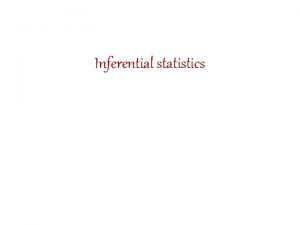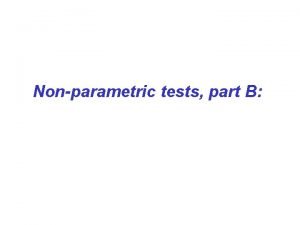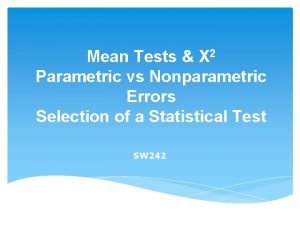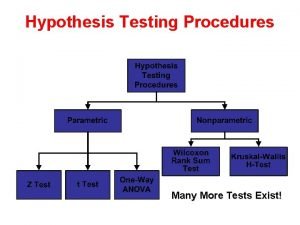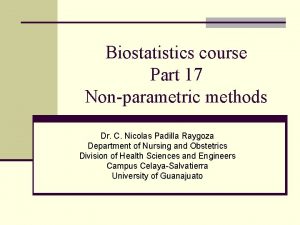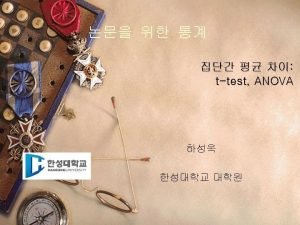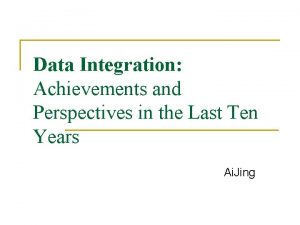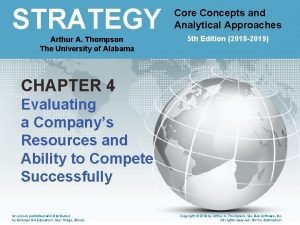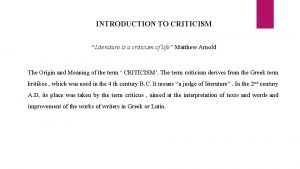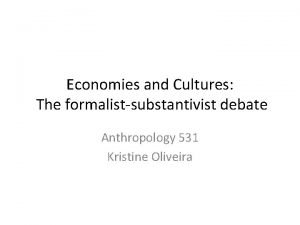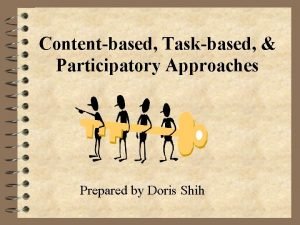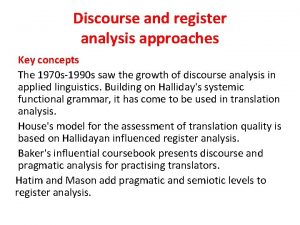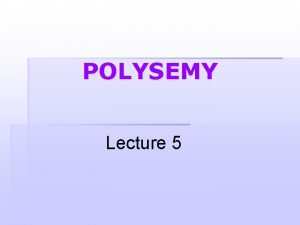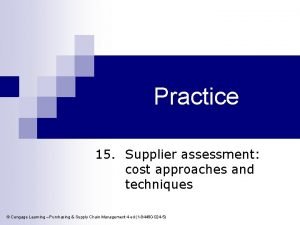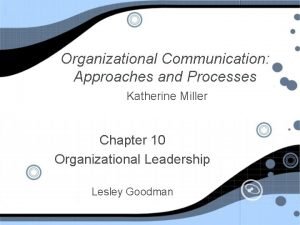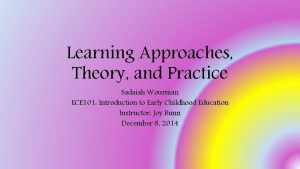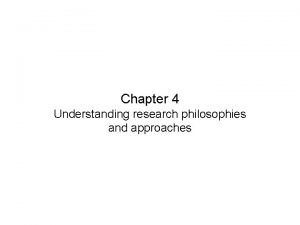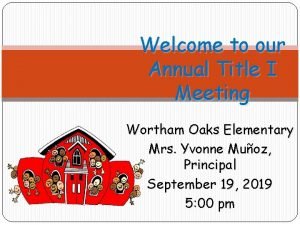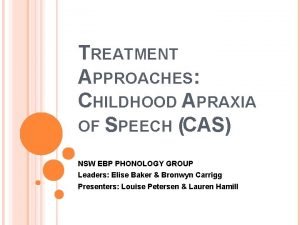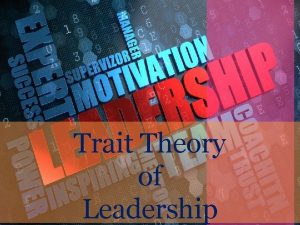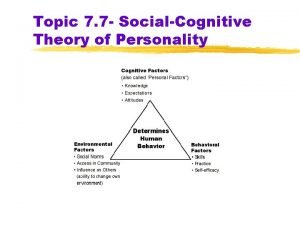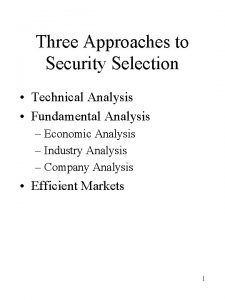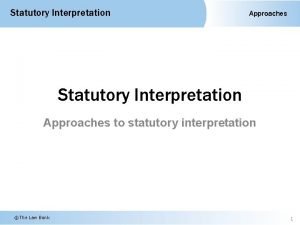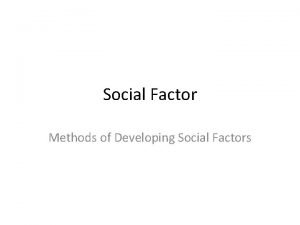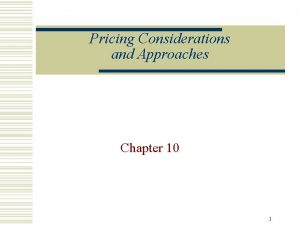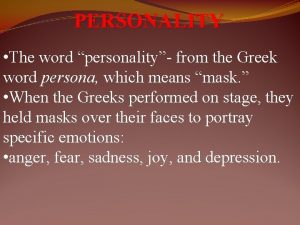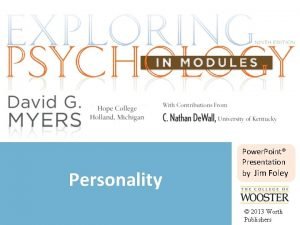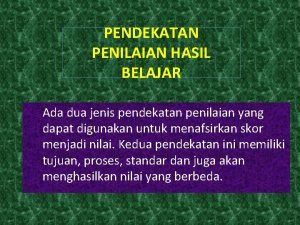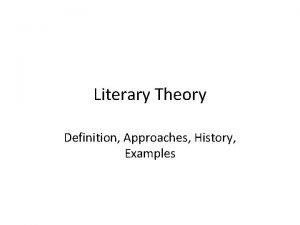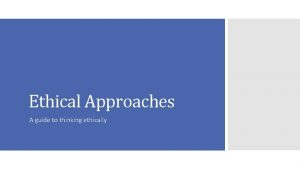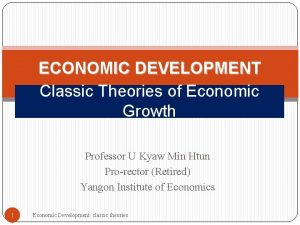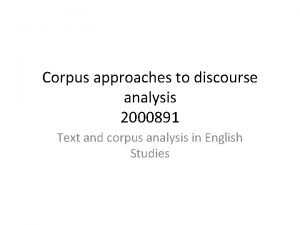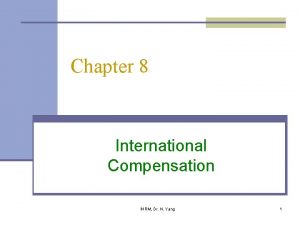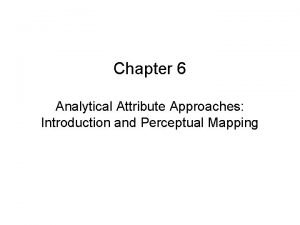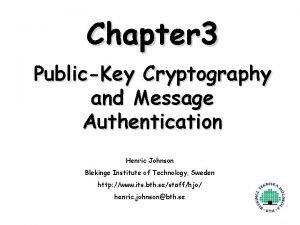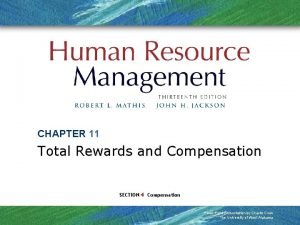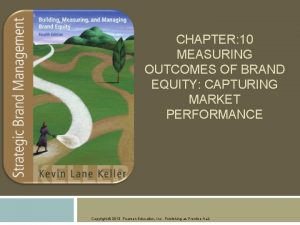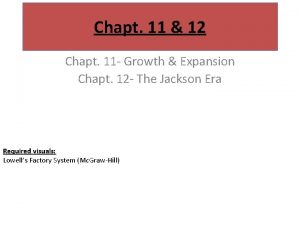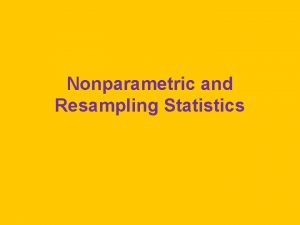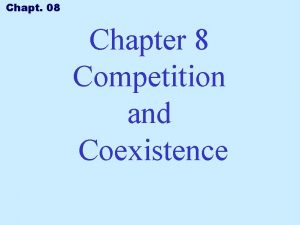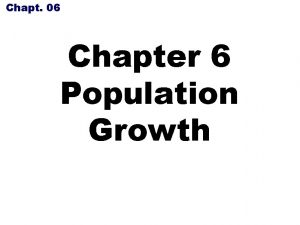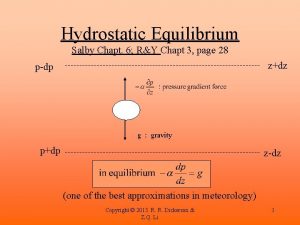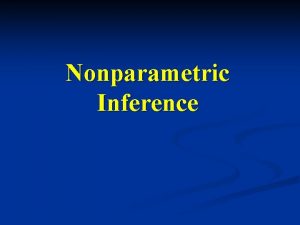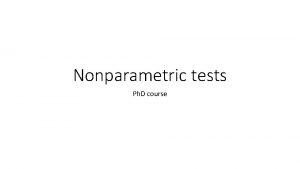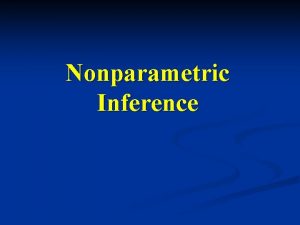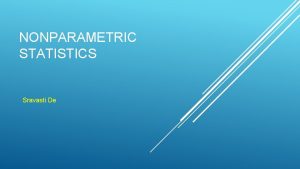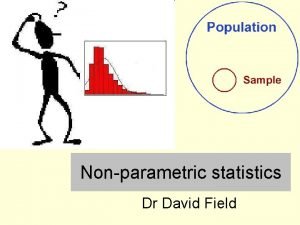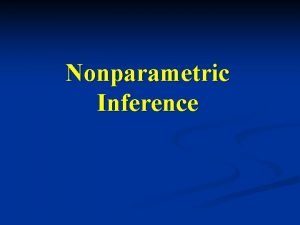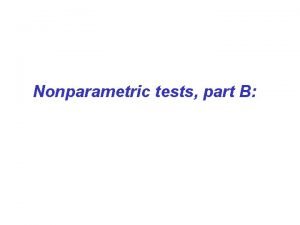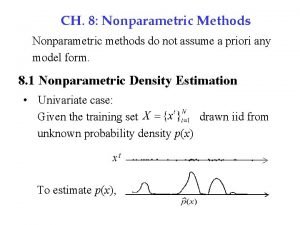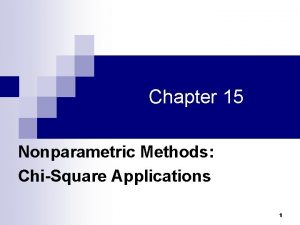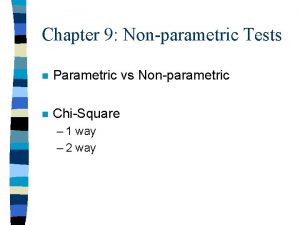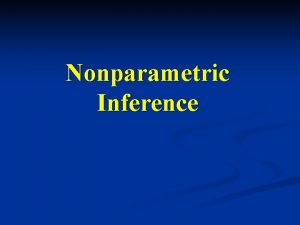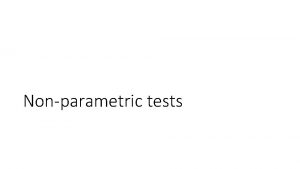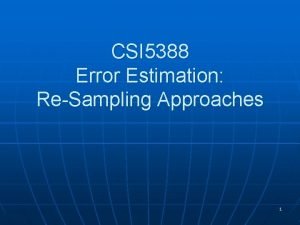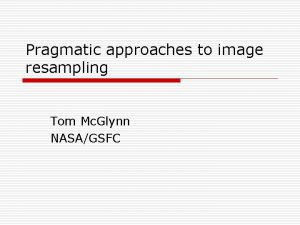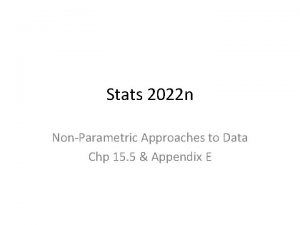CHAPT 18 Resampling and Nonparametric Approaches to Data












































































- Slides: 76

CHAPT 18 Resampling and Nonparametric Approaches to Data & CHAPT 6 Categorical Data and Chi (Kahy) -Square 1

PARAMETRIC TESTS § PARAMETRIC tests are more accurate than NONPARAMETRIC tests and they have 3 assumptions (research). § 1. Random selection § 2. Independent of observation § 3. Sample is taken from a normal population with a normal distribution 2

3

4

NONPARAMETRIC STATISTICAL TESTS or distributionfree tests § These tests which also used for hypotheses testing are rely on less restrictive assumptions about populations than parametric tests. § 1. Wilcoxon’s rank-sum test: § This test is often thought of as the distribution-free analogue of the t-test for two independent sample. § 2. The man-whitney U Test: § This test is very similar to Wilcoxon’s rank-sum test 5

NONPARAMETRIC STATISTICAL TESTS or distributionfree tests § 3. Kruskal-Wallis one way anova: § This test is direct generalization of the Wilcoxon’s rank-sum test to the case in which we have three or more independent groups. As such it is the distribution-free analogue of one way anova. 6

NONPARAMETRIC STATISTICAL TESTS or distributionfree tests § 4. Friedman’s rank test for K correlated samples: This test was developed by the well-known economist Milton Friedman. It is the distribution-free analogue of the oneway repeated-measures Anova. It is closely related to a standard repeated-measure ANVA applied to ranks instead of raw scores (see data on page 680). 7

5. CHI (Kahy) SQURE test for goodness of fit and Pearson CHI SQURE (special case) 8

CHI SQURE § CHI SQURE is similar to frequency distribution (f ). The ). independent observation is the basic assumption for a chisquare hypothesis test. § It is used for comparative studies (use ranking). 9

CHI SQURE § Ex 1. Of the two leading brands of cola, which is preferred by most Pepsi Coke Americans? 10

CHI-SQURE test for goodness of fit §Ex 2. which psychotherapy technique is used by most psychologists? e. g. Cognitive, Behavioral, Humanistic, CBT, Psychodynamics, etc. 11

CHI-SQURE test for goodness of fit 12

Problem 1 (one variable, eye color) § Distribution of Eye colors for a sample of n=40 individuals. § FYI From the chapter 2 Frequency Distribution § (X )eye colors (f ) frequencies § Blue 12 § Brown 21 § Green 3 § Other 4 see next slide for Chi square 13

Problem 1 § Distribution of Eye colors for a sample of n=40 individuals. § Frequency distribution Fo Blue Brown Green Others 12 21 3 4 14

Problem 1 § Distribution of Eye colors for a sample of n=40 individuals. § Frequency distribution Fo n=40 Fe Blue Brown Green Others 12 21 3 4 Blue Brown Green Others 10 10 15

The question for the hypothesis test is whethere any distribution of the four possible eye colors. Are any of the eye color distribution would be expected simply by chance? We will set alpha at α =. 05 § Step 1) H 0 : fo = fe no preference for any specific eye color H 1 : fo ≠ fe preference for specific eye color 16

Problem 1 § Distribution of Eye colors for a sample of n=40 individuals. § Frequency distribution Blue fo fe Brown Green Others 12 21 3 4 10 10 17

Step 2 df=(R-1)(C-1) 18

19

20

21

Problem 2 § A researcher examining art appreciation selected an abstract painting that had no obvious top or bottom. Hangers were placed on the painting so that it could be hung with any one of the four sides at the top. The painting was shown to a sample of n=50 participants, and each was asked to hung the painting in the orientation that looked correct. The following data indicate how many people choose each of the four sides to be placed at the top. fo Top up (correct) Bottom up Left side up Right side up 18 7 8 17 22

Problem 2 fo Top up (correct) Bottom up Left side up Right side up 18 17 7 8 Top up (correct) Bottom up Left side up Right side up 12. 5 n= 50 fe 12. 5 23

24

25

26

27

Problem 2 § The question for the hypothesis test is whethere any preferences among the four possible orientations. Are any of the orientations selected more (or less) often than would be expected simply by chance? § We will set alpha at α =. 05 28

Problem 2 § Step 1) H : fo=fe no preference for any specific 0 orientation H : fo≠fe 1 preference for specific orientation 29

Step 2 df=(R-1)(C-1) 30

31

32

33

§ The value of chi-square cannot be negative. § if the number of categories is increased, the critical value will decrease. 34

2 § c = Σ(fo-fe)² /fe Σ /fe § fo= observed frequency § fe= expected frequency § df=(R-1)(C-1) R is usually 2 for Chisquare test for independence (2 -1)=1 § R= # of Rows and C= # of Columns df=C-1 § fo = H 1 § fe = n/c = Ho or fe = pn where p is the proportion stated in the Null Hypothesis and n is the sample size. 35

Problem 3 § Ten years ago, only 15% (convert to proportion) of the U. S. population consisted of people more than 65 years old. A researcher plans to use a sample of n = 300 people to determine whether the population distribution has changed during the past ten years. If a chi-square test is used to evaluate the data, what is the expected frequency for the older-than -65 category? 36

Problem 3 § Ten years ago, only 15% of the U. S. population consisted of people more than 65 years old. A researcher plans to use a sample of n = 300 people to determine whether the population distribution has changed during the past ten years. If a chisquare test is used to evaluate the data, what is the expected frequency (fe) for the olderthan-65 category? Answer: 0. 15 X 300=45 § fe=p(n) 37

Problem 4 § A chi-square test for goodness of fit has df = 2. How many categories were used to classify the individuals in the sample? 38

Problem 4 § A chi-square test for goodness of fit has df = 2. How many categories were used to classify the individuals in the sample? § df=C-1 § 2=C-1 C=3 39

Problem 4. 1 § A researcher used a sample of n = 60 individuals to determine whethere any preferences among four brands of pizza. Each individual tastes all four brands and selects his/her favorite. If the data are evaluated with a chi-square test for goodness of fit using a =. 05, then how large does the chi-square statistic need to be to reject the null hypothesis? 40

Problem 4. 1 § A researcher used a sample of n = 60 individuals to determine whethere any preferences among four brands of pizza. Each individual tastes all four brands and selects his/her favorite. If the data are evaluated with a chi-square test for goodness of fit using a =. 05, then how large does the chi-square statistic need to be to reject the null hypothesis? Answer: >7. 82 see the critical values for chi-square on p. 691 41

Problem 5 Very tricky question § A sample of 100 people is classified by gender (male/female) and by whether or not they are registered voters. The sample consists of 80 females and 20 males, and has a total of 60 registered voters. If these data are used for a chisquare test for independence, what is the total number of females not registered for the expected frequencies? 42

Problem 5 Registered Not registered FEMALES f. R = 80 MALES f. R=20 f. C = 60 fc=40 43

Problem 5 Very tricky question § A sample of 100 people is classified by gender (male/female) and by whether or not they are registered voters. The sample consists of 80 females and 20 males, and has a total of 60 registered voters. If these data are used for a chi-square test for independence, what is the total number of females not registered for the expected frequencies? Answer: p=80/100=0. 80 § 60 registered voters means 40 not registered voters. § fe=p(n) 0. 80 X 40=32 44

THE CHI-SQUARE TEST FOR INDEPENDENCE (Pearson CHI SQURE) § The chi square statistic may also be used to test whethere is a relationship between two variables. In this situation, each individual in the sample is measured or classified on two separate variables. If the number of their categories don’t match then use df=(C -1)(C 2 -1) ex. next 1 45

Problem 6 § A chi-square test for independence is being used to evaluate the relationship between two variables, one of which is classified into three categories and the second of which is classified into four categories. The chi-square statistic for this test would have df equal to? 46

Problem 6 § A chi-square test for independence is being used to evaluate the relationship between two variables, one of which is classified into three categories and the second of which is classified into four categories. The chi-square statistic for this test would have df equal to? § Answer df=6 § df=(C -1)(C 2 -1) = (3 -1)(4 -1)=2 X 3=6 1 47

Problem 7 § A sample of 100 people is classified by gender (male/female) and by whether or not they are registered voters. The sample consists of 80 females and 20 males, and has a total of 60 registered voters. If these data were used for a chi-square test for independence, what is the expected frequency for males who are registered voters? 48

Problem 7 Registered Not registered FEMALES f. R = 80 MALES f. R=20 f. C = 60 fc=40 49

Problem 7 § A sample of 100 people is classified by gender (male/female) and by whether or not they are registered voters. The sample consists of 80 females and 20 males, and has a total of 60 registered voters. If these data were used for a chi-square test for independence, what is the expected frequency for males who are registered voters? Answer: p=20/100=0. 20 § fe=p(n) = 0. 20 X 60=12 0. 20 50

Problem 7. 5 § A sample of 100 people is classified by gender (male/female) and by whether or not they are registered voters. The sample consists of 80 females and 20 males, and has a total of 60 registered voters. If these data were used for a chi-square test for independence, what is the expected frequency for males who are NOT registered voters? Answer: p=20/100=0. 20 § 60 registered voters means 40 not registered voters. § fe=p(n) 0. 20 X 40=8 51

Problem 7. 6 § A researcher is using a chi-square test for independence to examine the relationship between TV preferences and gender for a sample of n = 100 children. Each child is asked to select his/her favorite from a fixed set of three TV shows and each child is classified as male or female. The chi-square statistic for this study would have df equal to …. . 52

§ Problem 7. 7 53

Problem 7. 8 § A chi-square test for independence has df = 3. What is the total number of categories (cells in the matrix) that were used to classify individuals in the sample? 54

Problem 8 § A chi-square test for independence has df = 3. What is the total number of categories that were used to classify individuals in the sample? § Answer: 8 § df= (R-1)(C - 1) § 3= (2 -1)(4 - 1) 55

Problem 9 § A researcher is conducting a chi-square test for independence to evaluate the relationship between gender and preference for three different designs for a new automobile. Each individual in a sample of n = 30 males and n = 30 females selects a favorite design from the three choices. If the researcher obtains a chi -square statistic of c 2 = 4. 81, what is the appropriate statistical decision for the test? § Try a =. 05 and then a =. 01 56

Hypotheses testing (step 1) §Ho: fo=fe §H 1: fo ≠ fe SPSS: Asymp. Sig is an abbreviation for asymptotic significance, which means that the significance is very close to 0 because you're WAY out in the tail of the test! 57

Step 2: Locate the Critical region df=(R-1)(C-1) 58

Step 3 59

Step 4 60

Effect size use Phi-Coefficient use for 2 by 2 data matrix 61

Effect size=Cramer‘s V use for more than 2 X 2 data matrix § For Cramer’s V, the value of df* is the smaller of either (R-1) or (C-1). 62

Effect size=Cramer‘s V use for more than 2 X 2 data matrix § Under what conditions is Cramér’s V used to measure effect size for a chi-square test for independence? Answer: When either of the two variables consists of more than two categories 63

§Special case of chisquare statistic next 64

THE CHI-SQUARE TEST FOR INDEPENDENCE (Pearson CHI SQURE) § The chi square statistic may also be used to test whethere is a relationship between two variables. In this situation, each individual in the sample is measured or classified on two separate variables. § Example next: fe=(fc. f. R)/n 65

Problem 10 § A researcher selects a sample of 100 people to investigate the relationship between gender (male/female) and registering to vote (registered/not registered). The sample consists of 40 females, of whom 30 are registered voters, and 60 males, of whom 40 are registered voters. If these data were used for a chi-square test for independence, what is the expected frequency for registered females? 66

Problem 10 § A researcher selects a sample of 100 people to investigate the relationship between gender (male/female) and registering to vote. The sample consists of 40 females, of whom 30 are registered voters, and 60 males, of whom 40 are registered voters. If these data were used for a chi-square test for independence, what is the expected frequency for registered females? § Answer: 28 fe=(fc. f. R)/n see next slide /n fe=(70 x 40)/100=28 67

Problem 10 FEMALES registered not registered 30 10 40 20 f. R = 40 f. R=60 f. C = 70 fc=30 68

Problem 11 Pearson CHI SQURE Males and females Willingness to use mental health services (Hypotheses testing) PROBABLY NO MAYBE PROBABLY YES 17 32 11 13 43 34 30 75 45 MALES FEMALES 69

70

71

Problem 11 Males and females Willingness to use mental health services (Hypotheses testing) PROBABLY NO MAYBE PROBABLY YES 17 32 11 13 43 34 30 75 45 MALES FEMALES 72

SPSS § § § § Click on Data Weight Casesy Weight Cases by fo Ok Click Analyze Descriptive Statistics Crosstabs R Row C Column Do not move the fo Click on Statistics Chi Square Continue Cick OK 73

74

Problem 12 § An insurance investigator has observed the people with some astrological signs tend to be safer drivers than the people with other signs. Using insurance records, the investigator classified 200 people according to their astrological signs and whether or not they were involved in a car accident during the previous 12 months. The data are as follows: 3 X 2 Accident n=40 10 20 70 40 50 No Accident N=160 Total=200 Do the data indicate a significant relationship between sign and accidents? Test at the. 05 level of 75 significance.

76
 Non-parametric t-test
Non-parametric t-test Types of statistics
Types of statistics Nonparametric test
Nonparametric test Parametric vs nonparametric test
Parametric vs nonparametric test Nonparametric test
Nonparametric test Nonparametric methods
Nonparametric methods Douwe postmus
Douwe postmus Data quality and data cleaning an overview
Data quality and data cleaning an overview Data integration problems approaches and perspectives
Data integration problems approaches and perspectives A comparison of approaches to large-scale data analysis
A comparison of approaches to large-scale data analysis What is wid, wad and gad
What is wid, wad and gad A company's resources and capabilities represent
A company's resources and capabilities represent Semantic structure of a word
Semantic structure of a word What is expressive criticism
What is expressive criticism Formalist and substantivist debate anthropology
Formalist and substantivist debate anthropology Content based task based and participatory approaches
Content based task based and participatory approaches 5 approaches to health promotion
5 approaches to health promotion Ib approaches to learning
Ib approaches to learning Structuralism in psychology
Structuralism in psychology Mode of discourse in register
Mode of discourse in register Solomon four group design
Solomon four group design What is teacher dominated approach
What is teacher dominated approach Synchronic and diachronic approaches to polysemy
Synchronic and diachronic approaches to polysemy Module 2 today's psychology and its approaches
Module 2 today's psychology and its approaches Develop new approaches to public governance and engagement
Develop new approaches to public governance and engagement Cost approaches and techniques in suppler assessment
Cost approaches and techniques in suppler assessment Katherine miller organizational communication
Katherine miller organizational communication Pricing considerations and approaches
Pricing considerations and approaches Learning approaches theory and practice
Learning approaches theory and practice Traditional grammar
Traditional grammar Linear perspective ap psychology
Linear perspective ap psychology Power bi governance
Power bi governance Research philosophies and approaches
Research philosophies and approaches Approaches meets masters
Approaches meets masters How did wilhelm wundt break down consciousness
How did wilhelm wundt break down consciousness Cas treatment approaches
Cas treatment approaches Trait approaches to leadership
Trait approaches to leadership Trait approaches to leadership
Trait approaches to leadership Social cognitive perspective of personality
Social cognitive perspective of personality Community oriented approach in tourism planning
Community oriented approach in tourism planning What are the three approaches to security?
What are the three approaches to security? The pearl vocabulary with page numbers
The pearl vocabulary with page numbers Mischief rule of interpretation
Mischief rule of interpretation Activity planning software project management
Activity planning software project management Social factors
Social factors School approaches to the education of eal students
School approaches to the education of eal students Nnn poem
Nnn poem Public policy stages
Public policy stages Trait theories
Trait theories General pricing approaches
General pricing approaches The word personality comes from the greek word __________
The word personality comes from the greek word __________ Social cognitive approaches to personality
Social cognitive approaches to personality Jenis penilaian hasil belajar
Jenis penilaian hasil belajar Approaches meets masters
Approaches meets masters Radar approaches
Radar approaches Theory definition
Theory definition Applying critical approaches to literary analysis
Applying critical approaches to literary analysis What is structuralist formalist
What is structuralist formalist Limits involving infinity asymptotes
Limits involving infinity asymptotes What is virtue ethics
What is virtue ethics Approaches to systems development
Approaches to systems development Trusteeship approach to industrial relations
Trusteeship approach to industrial relations Converging ils
Converging ils A framework for thinking ethically
A framework for thinking ethically Characteristics of educational planning
Characteristics of educational planning Dualistic development thesis
Dualistic development thesis What are the different literary approaches
What are the different literary approaches Corpus approaches to discourse analysis
Corpus approaches to discourse analysis Brown and clough theory on group living
Brown and clough theory on group living Expatriate compensation worksheet
Expatriate compensation worksheet Marketing research approaches to demand estimation
Marketing research approaches to demand estimation Analytical attribute approaches
Analytical attribute approaches Public key cryptography and message authentication
Public key cryptography and message authentication Compensation approach
Compensation approach How to measure outcomes of brand equity
How to measure outcomes of brand equity What are the five basic functions of the management process
What are the five basic functions of the management process New approaches to organizing hr
New approaches to organizing hr

